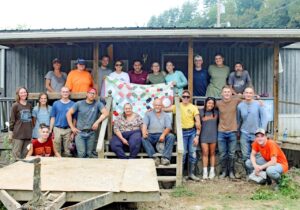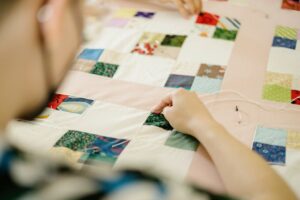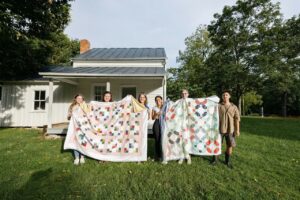As flooding decimated areas of eastern Kentucky in July, Danille Christensen, a folklorist and assistant professor of public humanities in the Department of Religion and Culture, searched for a way that she and her students could extend mutual aid. The idea she eventually settled on has its roots deep in Appalachia: a quilting.

The warm-hug symbolism of a quilt is almost too obvious. But as an expert in material culture, Christensen knows that quilts exist for moments like these. “That’s one of the main reasons quilts have been made: to be gifted,” she said. “And quiltings — the events that generate them — literally unite people. It’s collective action for the common good.”
So on a rainy afternoon in late August, some 40 students, most from Christensen’s Folk Cultures in Appalachia class, gathered in the 19th century Solitude and Fraction House to tie two quilts.
Not that they knew how to tie a quilt. Only one student raised her hand when Christensen asked the group who’d made a quilt before. “Most people my age don’t do stuff like this,” said senior Abby Conner, a geography major who nevertheless confessed to having bought quilting supplies over the summer in an itch to take up the craft. “I mean, I’m 21. What other 20-year-olds do you see making a quilt? It’s just one of those things that’s not as common anymore.”
With a quilt that Christensen pieced herself from scraps in a flurry of late nights over the previous week, she showed them how to stretch the quilt layers taut and secure them to borrowed wooden frames with thumbtacks. Someone threaded a mess of long needles with fine yarn. All they had to do was slide the needle through layers of cloth and batting, then double the stitch on top of itself. It would hold as securely as the multicolored eight-pointed-star quilt Christensen slept under as a child, strip-pieced and quilted by a great-grandmother who died before she was born.

Quilts are not unique to Appalachia, but they are woven into the culture here as a resourceful repurposing of fragments. The piecing and tying take effort and artfulness. Gathering to do it generates a sense of community and shared stories. “I’ve been studying the connections between material objects, actions and talk my entire career, and I thought that working on quilts together would help my students appreciate the skill and satisfaction that are part of craft work,” Christensen said.
She often encourages students to apprentice with artisans, whether welders or beekeepers or bakers. Usually they come away awed by the makers and the art form. “Students get a better appreciation for all of the thought and intention that goes into making something if they have to try to make it themselves.”
As the needles flew and the students rolled the edges of the quilt to reach the center, the other long-time purpose of a quilting — sometimes called a “bee” or a “frolic” — became apparent. This was a social occasion. Many hands made light work of such an enormous project and offered an excuse to share stories, music, and food. After several semesters fragmented by COVID, “I wanted students to have a chance to meet other people in the class,” Christensen said.

With Christensen’s quilt set up in Solitude and another brightly colored top donated by community member Cheryl Maggard in Fraction House, students started asking each other about their majors. They discussed football games and salsa night at the Milk Parlor. Volunteers from the Student Alumni Associates service organization chatted about their hometowns. As it has done for centuries, the quilt fostered a social nexus, a way for even the most reticent to participate by listening while working.
The setting in Solitude and Fraction House lent the event an air of low-key time travel. Very likely these homes had witnessed quiltings before, said Victoria Ferguson, the site’s program director. “The fact that we can have Fraction House today be in use for a purpose that it would have been used for when enslaved people lived there,” said Ferguson, “that’s what was exciting to me about being able to help with this quilting.”
Remembering her own experiences as a girl in West Virginia, Ferguson put a pot of pinto beans to simmer on the stove in Solitude. “That’s Appalachian culture: ‘Come on over, we’ll make a pot of beans,’” she said. “So I made beans.”

Emily Satterwhite, an associate professor in the Department of Religion and Culture, also brought a spread of Mediterranean food from Mezeh. A student set out a Tupperware of homemade chocolate chip cookies. Someone played Taylor Swift’s “Bad Blood” on her phone. Another student held up a flashlight app to light Solitude’s dim interiors. Why not? This wasn’t a reenactment, but a living tradition.
The needles went in and out, in and out, over patchwork that evoked Christensen’s personal history. “Quilts are such complicated things,” she said. “The fabrics tell stories through color and design — and, if they’re scraps, through their previous lives as garments.”
There was the blue cotton from her first (failed) attempt to sew shorts in middle school; the green from the Roman shades in her first college apartment; the madras plaid of a shirt her father wore as a child. There were even bits of polyester and seersucker quilt blocks sewed together by her great-grandmother. Together, they created a pattern called “around the garden,” white blooms framed by bright corners.

After a few hours of work, the two quilts were tied. Christensen would have some final hours of work to bind up the edges in time to send them off to Kentucky with volunteers from Appalachian Studies’ Societal Health class. Another seven completed quilts — bright checkerboards of color — were donated anonymously by a family with roots in Buchanan County. Students and faculty delivered the quilts on Sept. 3 to families recovering from the flood’s traumas, some now living in tents. One recipient shared her own quilts, and their stories, in return.
Of course, you could go to any store and buy a blanket. But quilts require so much labor and care that “it’s a little thing that has kind of outsized meaning,” said Christensen. As if the act of making them stitches a message into the fabric, alongside its other meanings: We know things are hard. You matter to us.

